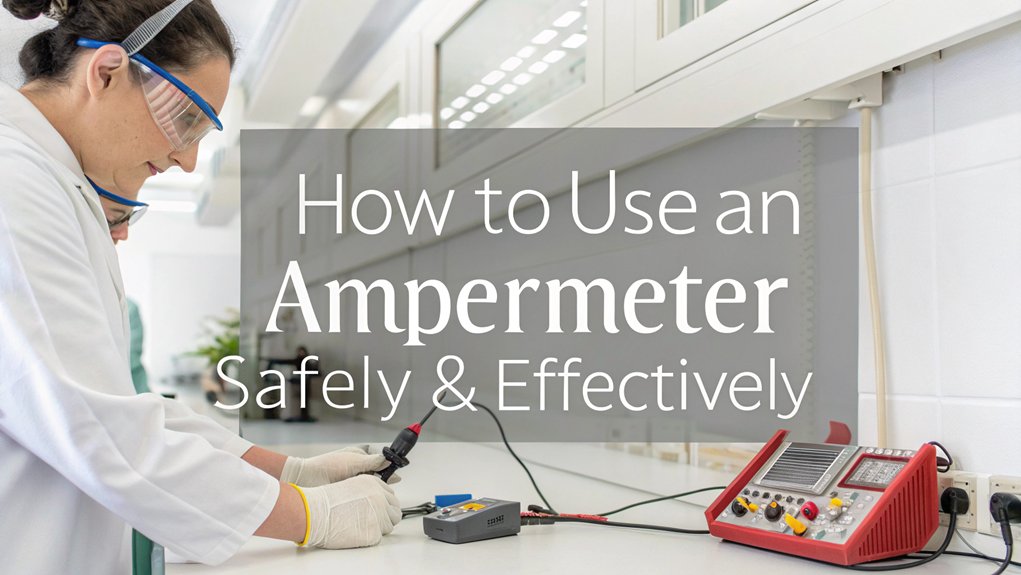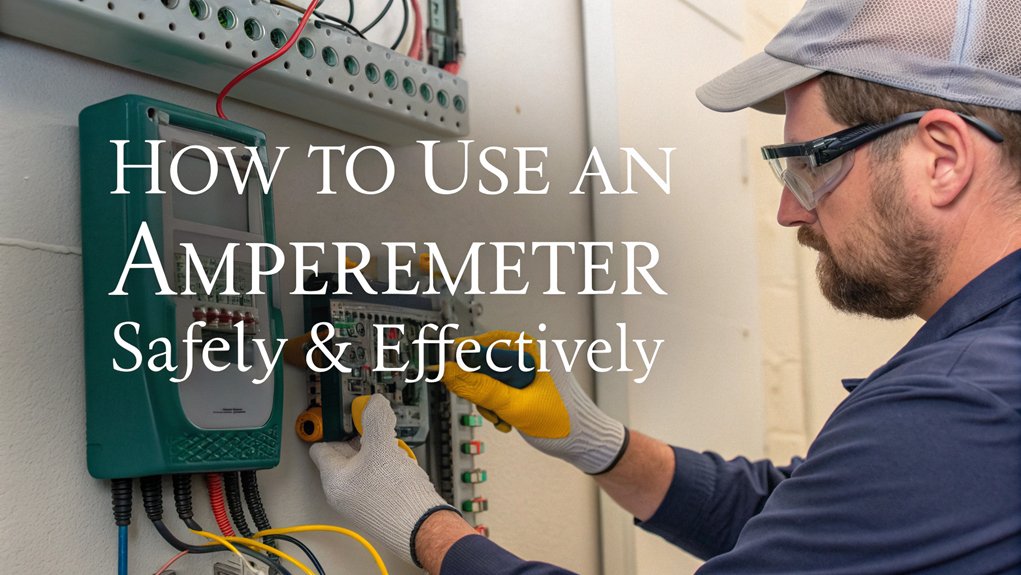To use an amperemeter safely and effectively, start by setting it to the highest current range before connecting it in-series with the circuit. Always check if your circuit uses AC or DC and adjust settings accordingly. Verify the internal fuse is functional to avoid incorrect readings. Use insulated gloves and avoid exceeding the ammeter’s capacity to prevent damage. Connect and disconnect carefully to guarantee accurate measurements. These steps guarantee safe and accurate current diagnostics, with further insights available.
TLDR
- Always set the ammeter to the highest current range before connecting to prevent damage from high currents.
- Connect the ammeter in series with the circuit to ensure accurate current measurements without altering circuit behavior.
- Verify the ammeter’s internal fuse functionality before each use to avoid incorrect readings or damage.
- Use insulated gloves and follow safety precautions to protect against electric shocks while handling the ammeter.
- Never exceed the ammeter’s rated capacity to prevent overheating and permanent damage.
Understanding the Basics of Ammeters
An ammeter is essential for diagnosing electrical circuits by measuring current in amperes. Whether dealing with AC or DC, using an ammeter correctly guarantees you measure current accurately.
Connect in-series ammeters directly into the circuit, while induction ammeters use a non-invasive clamp. Always select the appropriate setting for AC or DC measurement. Keep the ammeter’s internal resistance low to avoid affecting the circuit’s performance.
Use test probes carefully and guarantee proper usage by adhering to safety precautions. Check the ammeter’s internal fuse and power off the circuit during connections. These steps prevent errors and protect both you and the equipment during use.
Mastering these basics will help you diagnose electrical issues with confidence and precision.
Preparing Your Amperemeter for Use
Before you begin using an ammeter, make certain to prepare it properly to confirm accurate and safe measurements. Start by setting the ammeter to the highest current range to avoid initial damage. Identify if the circuit uses AC or DC current and adjust the ammeter’s settings accordingly. Inspect the internal fuse using the continuity mode to validate functionality. Guarantee safety by powering off the circuit and removing batteries before making a break in the wiring. Typically, this break is between the negative terminal and the load. Prepare test leads for proper connections.
| Step | Action |
|---|---|
| Set Current Range | Highest setting initially |
| Check Current Type | Select AC or DC |
| Test Internal Fuse | Use continuity mode |
| Break in Wiring | Disconnect at negative terminal for connection |
This preparation guarantees effective and safe usage of the ammeter.
Properly Connecting an Amperemeter in a Circuit
When you’re ready to connect an ammeter in a circuit, make sure you begin by setting the device to its highest current range to prevent possible damage from excessive current.
First, create a break in the circuit by disconnecting the wire, typically between the negative terminal and the powered device. Insert the ammeter in series by connecting the negative lead (black) to the power source side of the break and the positive lead (red) to the opposite side.
Ascertain that only one wire is connected at a time. Avoid contact with other conductive surfaces to prevent short circuits.
Once connected, restore power to the circuit. Observe the ammeter display for current measurement, adjusting the range if necessary.
Taking Accurate Readings With an Amperemeter
Having successfully connected your ammeter in series, focus now on taking accurate readings, which is essential for understanding current flow in your circuit. Start by setting the ammeter to the highest range to prevent overloading. Restore power, then observe the display for the current measurement. If needed, adjust the range for precision, guaranteeing that the readings fall within the ammeter’s ideal range. Always disconnect the ammeter before altering the circuit to maintain safety and accuracy.
| Step | Action |
|---|---|
| Initial Setup | Set ammeter to highest range before connections |
| Power On | Restore circuit power and observe the display for readings |
| Adjust Range | Fine-tune range if necessary for accurate current measurement |
| Disconnection | Turn off power and disconnect the ammeter to guarantee safety and prepare for future measurements |
Safety Tips and Best Practices for Using an Amperemeter
Although using an amperemeter might seem straightforward, adhering to safety tips and best practices guarantees both your safety and the instrument’s longevity.
Start by setting the ammeter to the highest current range before connecting it. This precaution prevents damage from unexpected high currents. Always connect the ammeter in series with the circuit to confirm accurate measurements without altering circuit behavior.
Verify the internal fuse’s functionality before each use; a blown fuse can lead to incorrect readings or device damage. Use insulated gloves and follow safety precautions to protect yourself from electric shocks when handling electrical devices.
Never exceed the ammeter’s rated capacity to avoid overheating and permanent damage. Ascertain test leads are in good condition to maintain reliability.
Frequently Asked Questions
How to Properly Use an Ammeter?
To properly use an ammeter, start by setting it to the highest current range. Select AC or DC as needed.
Disconnect the circuit and connect the ammeter in series—negative to the power source, positive to the load. Check the internal fuse before each use.
Power the circuit, note the current, then power off to safely disconnect. Test one wire at a time to guarantee accurate readings and prevent damage.
What Precautions Should Be Taken While Using an Ammeter?
When using an ammeter, consider that 25% of electrical accidents result from improper equipment handling.
Start by ensuring it’s set to the highest range to prevent damage. Double-check it’s suitable for AC or DC. Verify the internal fuse is intact for accurate readings.
Turn power off before connecting, and attach leads correctly—red to positive, black to negative.
Avoid measuring multiple wires to maintain precision and safety.
How Can You Avoid Damaging an Ammeter?
To avoid damaging an ammeter, start by setting it to the highest current range before connecting.
Make sure it’s connected in series, not parallel, to prevent shorts. Regularly check the internal fuse for continuity, indicating potential overcurrent issues.
Use the correct AC or DC settings to maintain reading accuracy. Secure connections diligently and never exceed the ammeter’s rated capacity, as this can lead to permanent damage or failure.
What Are the Two Important Things When Using an Ammeter?
Did you know that improper use of an ammeter can reduce its lifespan by up to 30%?
When using an ammeter, always connect it in series to accurately measure current without altering the circuit. Start with the highest range setting to prevent damage, then adjust downwards for precision.
Confirming the internal fuse is essential for reliability. These practices help maintain the ammeter’s longevity and guarantee safe, accurate readings.
Conclusion
As you wrap up your exploration of the amperemeter, picture the steady pulse of electrical currents flowing seamlessly through the circuit. You’ve mastered the art of preparation, ensuring each connection clicks into place like pieces of a puzzle. With precise readings illuminating your path, your vigilance safeguards against potential hazards. Embrace these best practices, and you’ll wield your amperemeter with the confidence of an artist painting with electrons, capturing the invisible energy that powers our world.

